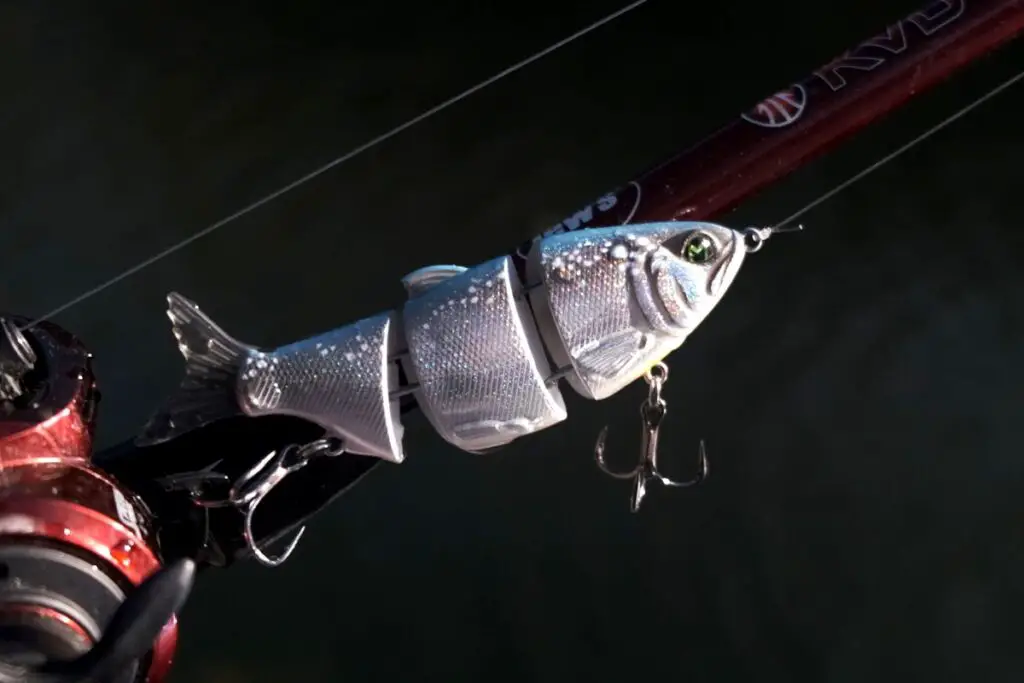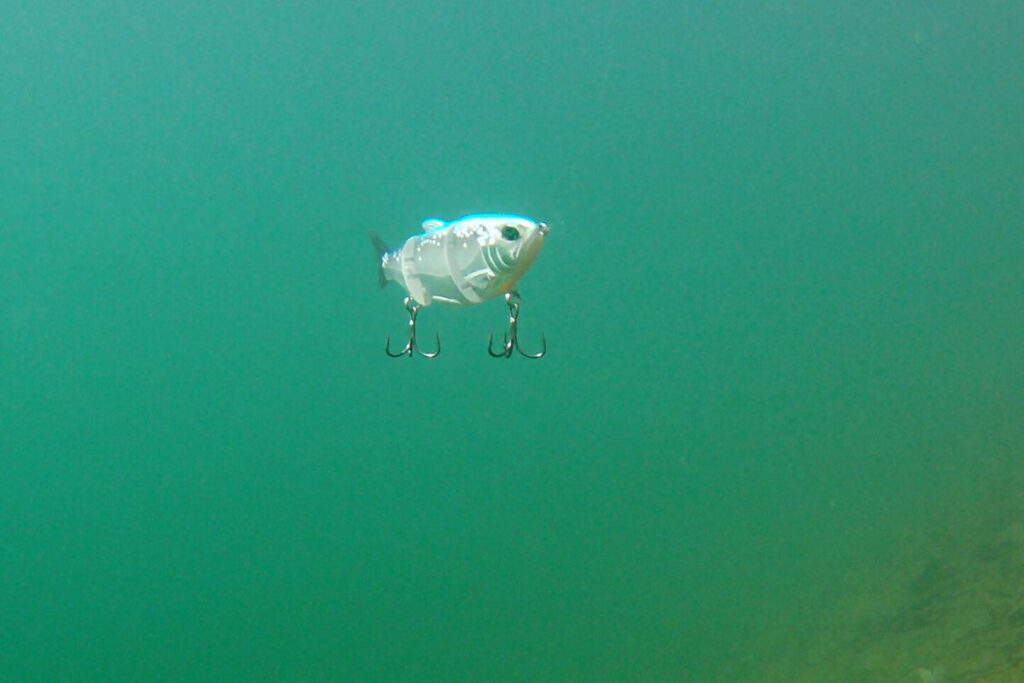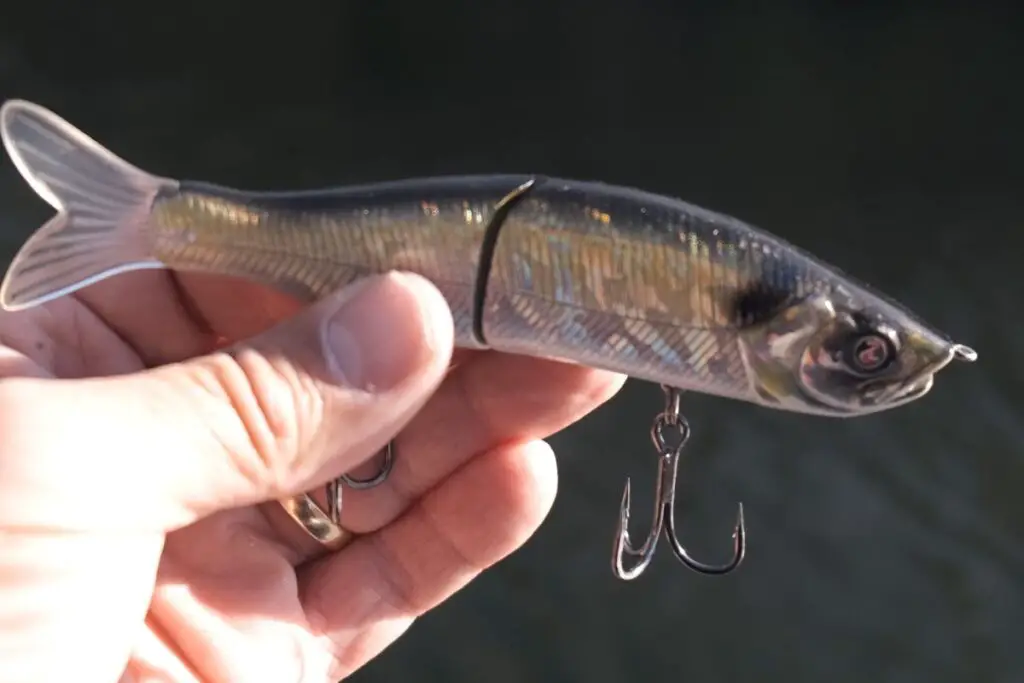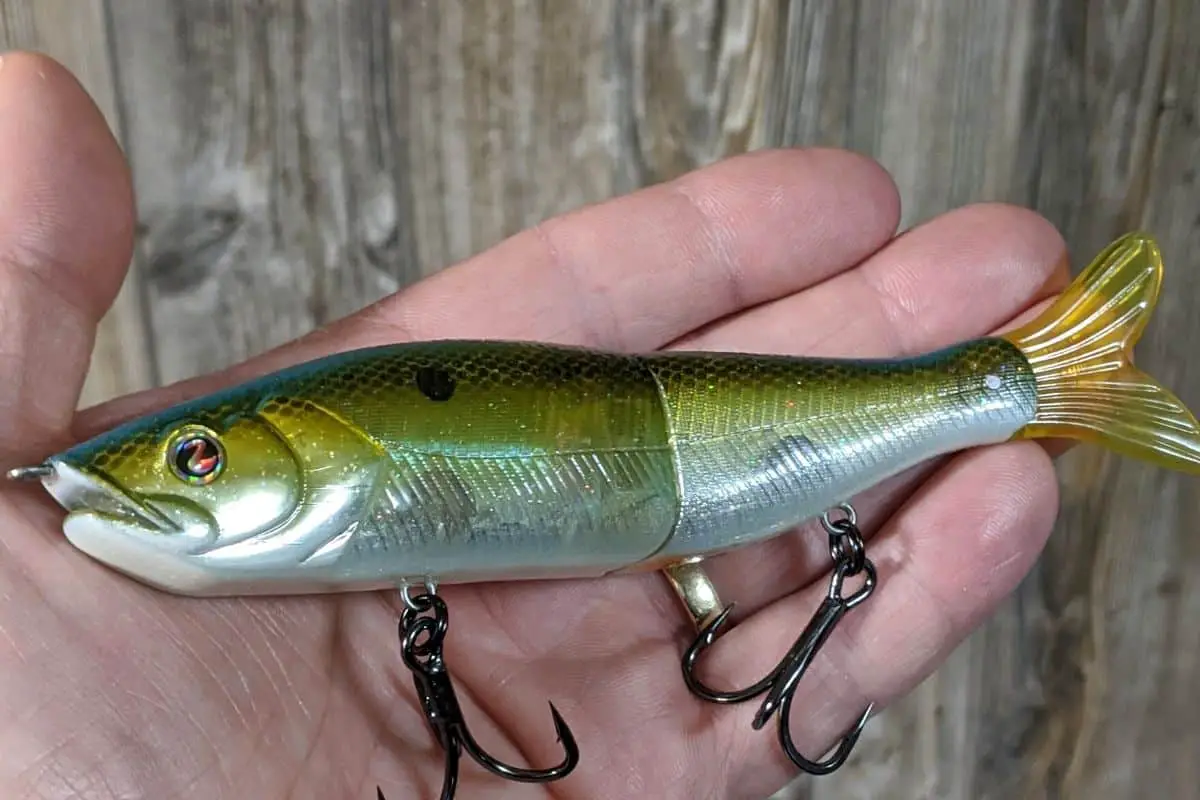In the last decade, these two lures have grown in popularity. Both professional bass anglers and recreational fishermen use these lures on a regular basis. And for good reason – they find and catch bass.
Hard swim baits generally have multiple joints while a glide bait will have one pivot point. Swim baits have several different retrieves that work well. Glide baits excel with the traditional sliding, or gliding, retrieve.
Understanding the differences between these two hard lures will help you choose the best one for the given situation. We will also discuss the proper equipment selection for each lure.

Physical Design Characteristics of Swim Baits and Glide Baits
As mentioned above, a swim bait will often have multiple joints or pivot points. Most models have at least two articulating connections but may have as many as four.
A glide bait will have one pivot point.
Hard swim baits are often smaller in size. Lengths of 3 ½” to 5” are common. The Mach Shad is 3 ½” in length and weighs 7/16oz. The popular 5” Bull Shad hard swim bait is 1.35oz. There is a 9” Bull shad as well, but most stores will carry the smaller version.
Swim baits are more costly than other hard lures, like a traditional squarebill crankbait. For example, the Mach shad can be purchased for $14.99. At the other extreme is the Bull Shad which starts at $50.

Glide baits tend to be much larger in size. The popular S-Waver by River 2 Sea comes in both 6 ¾” and 8” and will run you $18-$20. The larger weighing in at 3 1/2oz. That is a hefty bait. Other glide baits, like the Deps Slide Swimmer 250 are 10” long and cost $170.
Both hard swim baits and glide baits have the line tie positioned on the nose of the lure. The placement is critical to getting the best action.

What Swim Baits and Glide Baits do Well
These lures excel at presenting an easy meal for bass – especially big bass.
The tempting action is best utilized when fishing water with some visibility. The lures can draw fish from quite a distance. The farther they can see the better. When fishing clean water wind and some waves are what you will want to be around. If the water is dirtier, calmer conditions are best for these lures.
The two baits can also get eaten by some huge bass. This is even more so with the larger lures. Many dedicated big glide bait anglers are only fishing for a few bites a day, but those bites are going to be from some lunker bass.
While we love catching bass, it cannot be forgotten that these two lures get fish to reveal themselves as well. In fact, in my mind, this may be the most important reason for using swim baits and glide baits. They receive lots and lots of follows.
So how is this good if the bass doesn’t eat the lure?
It lets us know where the bass are and what they are relating to. We can then go back with other presentations and work an area thoroughly. The 3-pounder that followed that hard swim bait may have just been curious. Knowing where the bass was means we can refocus on that spot with something like a shaky head. We may catch the fish that followed plus many others.
I like to think about swim baits and glide baits as “reveal” baits.

How Swim Baits and Glide Baits Differ in Retrieves
The glide bait basically has one retrieve style, with a couple of slight variations.
The lure glides in a large “S” pattern that goes from side-to-side. Anglers can speed the glide up slightly or slow it down and even vary the length of the pause between twitches.
Probably the most noteworthy difference is that the retrieve for the glide bait is all done with the reel. In other words, glide bait anglers are not twitching the rod tip, they are giving a quick turn of the reel handle and then a pause, then another quick turn. This rotation is often between 1/4 and 1/2 of a full turn.
A hard swim bait lets anglers decide if they want to reel it straight back on a slow, steady retrieve, let it sink, or throw in twitches with the rod tip that gives the lure that fleeing baitfish look. This sudden burst forward can trigger even the most reluctant bass into eating.
Most hard swim baits also will drop perfectly horizontal. In other words, they do not dive nose down. This slow-sink can be what bass really want on some days.
Keep mixing up the retrieve until you discover what the fish want at that moment.
(Here is an article on the difference between a power shot rig and a drop shot.)
Equipment for Fishing Hard Swim Baits and Glide Baits
The smaller hard swim baits do not require rods and reels much different than what you are already using. In fact, for the 3 ½” Mach Shad, I use the same rod and reel as my hard, suspending jerkbait setup.
It is a medium-heavy power rating with a fast action. I may opt for a longer rod, something in the 7’2″ – 7’4” range to help with distance casting, but it is not necessary.
As far as line, I will often start with straight 15lb test fluorocarbon. I will scale down the line if bites are scarce.
The larger glide baits require a different equipment configuration.
First, most glide bait anglers will use a snap and a swivel. These two pieces of equipment are critical for the lure to cast and retrieve properly. I know that most bass anglers never use snaps, I am one of them, but this glide bait presentation is best with them.
The swivel is important on the long cast. These flat-sided lures will want to rotate and turn in the wind. When spooled up with fluorocarbon line, this can lead to some horrible line twist.
The snap gives the glide bait a wide pattern when retrieving the lure. We want the full side-to-side action. I like to use the VMC Duolock snaps in a size #4, 5 or 6.
As far as the rod, many die-hard glide bait anglers are using setups in the 8’ range that are a medium-heavy or heavy power rating with fast actions. Twenty-pound test fluorocarbon is a great starting point for line, and a higher-capacity reel is nice, but not necessary.
Good luck with your hard swim bait and glide bait fishing. And make sure to encourage someone today, you never know how you may change their life forever.
Isaiah 6:8

